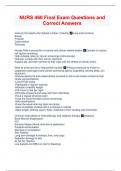NURS 460 Final Exam Questions and Correct Answers Cancers that lead to the highest number of deaths ✅Lung and bronchus Breast Prostate Colon/rectum Pancreas Nurses Role in prevention of cancer and cancer related deaths ✅Educate on cancer risk factors (smoking) Help increase rates on cancer screenings (colonoscopy) Help pts. comply with their cancer regimens Support pts. and their families as they cope with the effects of cancer and tx What to avoid and do to help prevent cancer ✅-Reduce exposure to known or suspected carcinogens and cancer -promoting agents (cigarettes, tanning beds, sun exposure) -Reduce dietary fat and preservatives (smoked or salt -cured meats containing high nitrate concentrations) -Limit ETOH intake -Participate in regular exercise -Maintain a healthy weight -6-8 hours of rest per night -Eliminate stressors and cope with them effectively -Have a regular physical exam -Have the recommended cancer screenings -Self-examinations -Know the seven warning signs on cancer -Seek immediate medical care if a change is noticed -Wear proper clothing (gown, flows, respirator) when working with chemicals Common side effects of chemotherapy and radiation therapy ✅Allopecia Bone Marrow Suppression N/V Extreme fatigue (blood clots due to sedentary) Possible extravasation Diarrhea or constipation Skin Rashes Long term damage to kidneys, liver, and lungs Radiation damage to skin At risk for infection Low platelet and WBC (at risk for bleeding) Tx options to prevent complications from chemo and radiation ✅Prophylactic antiemetics Anti-diarrheals, stool softeners, iron supplement Discuss hair loss Establish a time to take a daily walk -want to conserve energy Infection prevention Include pt. in diet planning Eat small, frequent meals Good oral hygiene (examine for sores in mouth) Proper hand hygiene Protect skin from the sun Avoid swimming pools Soft bristle toothbrush Diet Modifications for Chemo ✅Soft, bland, moist foods High-protein, high -calorie Small frequent meals No strong smells Avoid irritating foods (spicy, acidic, hot/cold) Low-residue/fiber for diarrhea High-fiber for constipation Nutrition supplements drink 3L of fluid a day Eat/drink when not nauseated No veggies from the ground PET Scan ✅used to identify abnormal cellular activity can give an accurate staging of cancer Pt. is injected w/ radioactive dye Dye goes to areas with higher levels of activity (cancer cells) and shows as a brighter color on the scan Biopsy ✅Removal of tissue sample for pathologic analysis •Endoscopic —lung, colon, bladder •Surgical —tumor hard to reach —laparotomy, thoracotomy, craniotomy •Fine needle aspiration — cells to examine •Large core biopsy —larger piece of tissue •Excisional biopsy —removal entire lesion, lymph node, nodule, etc. Platelet count ✅What lab value is important to know prior to cancer tx carcinoma in situ ✅cancer in the early stage before invading surrounding tissue abnormal cells, not cancer TNM staging system ✅Primary tumor (T): tumor size and invasiveness -0: no evidence of primary tumor -is: Carcinoma in situ -1-4: Ascending degrees of increase in tumor size and involvement -x: tumor cannot be measured or found Regional lymph nodes (N): presence or absence of regional spread to lymph nodes -0: No evidence of disease in lymph nodes -1-4: Ascending degrees of modal involvement -x: Regional lymph nodes unable to be assessed clinically Distant Metastases (M): Metastasis to distant organ sites -0: No evidence of distant metastases - 1-4: Ascending degrees of metastatic involvement, including distant nodes -x: Cannot be determined Change in bowel/bladder habits A sore that does not heal Unusual bleeding or discharge form any body orfrice Thickening of a lump in the breast or elsewhere Indigestion or difficulty in swallowing Obvious change in wart or mole Nagging cough or hoarseness ✅What does the acronym CAUTION stand for? Treatment for head and neck cancer ✅Surgery is initial Chemo and radiation Complications of head and neck cancer ✅Malnourishment so need feeding tube placement Placement of trach Loss of voice -need voice assistant device Inability to swallow Disturbed body image loss of strength and mobility -physical therapy swelling -airway compromise Nursing Dx for head and neck cancer ✅Ineffective airway clearance -dehydration Risk for aspiration Anxiety Acute pain Impaired verbal communication Disturbed body image Impaired skin integrity Bleeding Hodgkin's lymphoma ✅-Reed -Sternberg cells located in lymph nodes -enlargement of cervical, axillary, and inguinal lymph nodes -mediastinal node mass -weight loss, fatigue, weakness, fever, chills, tachycardia, night sweats -ETOH induced pain Non-Hodgkin's Lymphoma ✅-can originate outside the lymph nodes -painless lymph node enlargement -other s/s depend on where the disease has spread (hepatomegaly or neurologic sx) Acute Myelogenous Leukemia (AML) ✅Myelobalsts located in bone marrow Abrupt and strong, serious changes (infection) and bleeding from the beginning Uncontrolled growth of myeloblasts Hyperplasia of bone marrow Smoking and genes (Downs Syndrome, if your sibling has ALL or AML then you have a higher chance) Acute Lymphocytic Leukemia (ALL) ✅Immature small lymphocytes develop and proliferate in bone marrow CNS changes Insidious (slow) from beginning and neuro involvement Fever at diagnosis Diagnosis of Acute myelogenous leukemia ✅•Increased incidence >60 •Fatigue, weakness •Anemia, bleeding •Fever, infection •Enlarged spleen and liver •Low RBC, HGB, HCT, platelet Diagnosis of acute lymphocytic leukemia ✅•2-5 years old and >50 year old •Fatigue, weakness •Fever •Bleeding, pallor •Enlarged lymph nodes •Enlarged spleen and liver •CNS involvement •Low RBC, HGB, HCT, platelet




